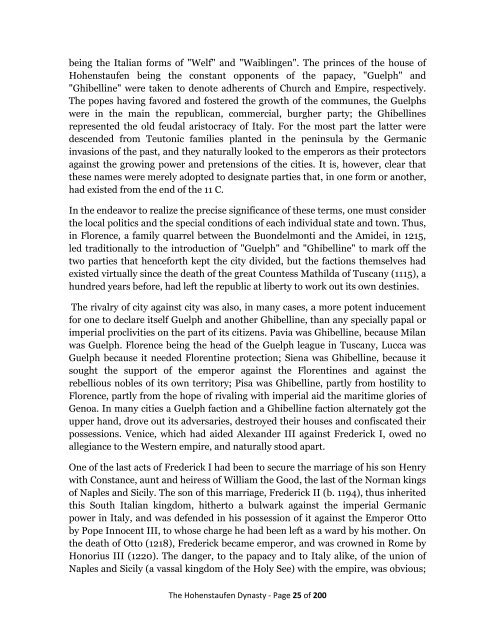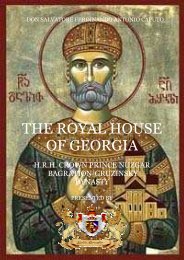here - Nobility Associations
here - Nobility Associations
here - Nobility Associations
Create successful ePaper yourself
Turn your PDF publications into a flip-book with our unique Google optimized e-Paper software.
eing the Italian forms of "Welf" and "Waiblingen". The princes of the house of<br />
Hohenstaufen being the constant opponents of the papacy, "Guelph" and<br />
"Ghibelline" were taken to denote ad<strong>here</strong>nts of Church and Empire, respectively.<br />
The popes having favored and fostered the growth of the communes, the Guelphs<br />
were in the main the republican, commercial, burgher party; the Ghibellines<br />
represented the old feudal aristocracy of Italy. For the most part the latter were<br />
descended from Teutonic families planted in the peninsula by the Germanic<br />
invasions of the past, and they naturally looked to the emperors as their protectors<br />
against the growing power and pretensions of the cities. It is, however, clear that<br />
these names were merely adopted to designate parties that, in one form or another,<br />
had existed from the end of the 11 C.<br />
In the endeavor to realize the precise significance of these terms, one must consider<br />
the local politics and the special conditions of each individual state and town. Thus,<br />
in Florence, a family quarrel between the Buondelmonti and the Amidei, in 1215,<br />
led traditionally to the introduction of "Guelph" and "Ghibelline" to mark off the<br />
two parties that henceforth kept the city divided, but the factions themselves had<br />
existed virtually since the death of the great Countess Mathilda of Tuscany (1115), a<br />
hundred years before, had left the republic at liberty to work out its own destinies.<br />
The rivalry of city against city was also, in many cases, a more potent inducement<br />
for one to declare itself Guelph and another Ghibelline, than any specially papal or<br />
imperial proclivities on the part of its citizens. Pavia was Ghibelline, because Milan<br />
was Guelph. Florence being the head of the Guelph league in Tuscany, Lucca was<br />
Guelph because it needed Florentine protection; Siena was Ghibelline, because it<br />
sought the support of the emperor against the Florentines and against the<br />
rebellious nobles of its own territory; Pisa was Ghibelline, partly from hostility to<br />
Florence, partly from the hope of rivaling with imperial aid the maritime glories of<br />
Genoa. In many cities a Guelph faction and a Ghibelline faction alternately got the<br />
upper hand, drove out its adversaries, destroyed their houses and confiscated their<br />
possessions. Venice, which had aided Alexander III against Frederick I, owed no<br />
allegiance to the Western empire, and naturally stood apart.<br />
One of the last acts of Frederick I had been to secure the marriage of his son Henry<br />
with Constance, aunt and heiress of William the Good, the last of the Norman kings<br />
of Naples and Sicily. The son of this marriage, Frederick II (b. 1194), thus inherited<br />
this South Italian kingdom, hitherto a bulwark against the imperial Germanic<br />
power in Italy, and was defended in his possession of it against the Emperor Otto<br />
by Pope Innocent III, to whose charge he had been left as a ward by his mother. On<br />
the death of Otto (1218), Frederick became emperor, and was crowned in Rome by<br />
Honorius III (1220). The danger, to the papacy and to Italy alike, of the union of<br />
Naples and Sicily (a vassal kingdom of the Holy See) with the empire, was obvious;<br />
The Hohenstaufen Dynasty - Page 25 of 200



